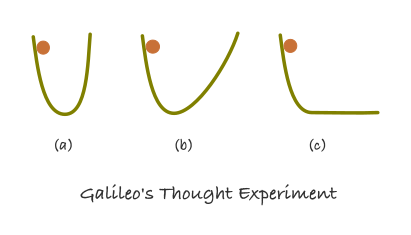One day at the Cathedral of Pisa, Galileo who was still a teenager, watched a chandelier that a monk had just lit swinging in an arc. Using his medical training, he started timing the motion and discovered that even though the swing got shorter and shorter, the time of each swing stayed the same. That observation so excited him, that he rushed back home to experiment with strings and weights, and it eventually led to a life long fascination with pendulums and motion.
But one of his most interesting discoveries, one that was incorporated in Newton’s first law of motion, was not the product of direct experimentation. It was his ability to imagine a scenario that was almost impossible to replicate in real life. It’s what Ernst Mach later called as a Gedankenexperiment, or a thought experiment.
Galileo realized that without friction, a ball rolled along a double incline plane will reach its original height on the other side just like a pendulum (Fig. a). He then asks to imagine what would happen if one side of the double inclined plane is made longer. The ball will then travel a longer distance till it retains its original height (Fig. b). In the limiting case of infinite length, the ball would continue rolling since it can’t reach its original height (Fig. c). This completed upended the Aristotelian view of motion that the natural state of a body is that of rest, and motion requires some force.
Thought experiments have played a significant role in the history of Science from Galileo to Einstein. Scientists expand knowledge of a concept, by creating mental models and running virtual experiments on them. In fact, cognitive scientists believe that people reason by carrying out thought experiments on internal mental models.
But more than that, thought experiments are essentially a creative exercise. Creativity at its core is about playing with models – changing different aspects or adding new associations – and iterating to find a better solution. Whether it is using SCAMPER to manipulate an attribute or reversing an assumption, creative thinking provides ways to manipulate mental models in a quest to discover breakthrough ideas.
As Nancy Nersessian, an expert on model-based thinking in Science, explains, “While thought experimenting is a truly creative part of scientific practice, the basic ability to construct and execute a thought experiment is not exceptional. The practice is highly refined extension of a common form of reasoning. It is rooted in our abilities to anticipate, imagine, visualize, and re-experience from memory. That is, it belongs to a species of thinking by means of which we grasp alternatives, make predictions, and draw conclusions about potential real-world situations we are not participating in at that time.”
While the role of thought experiments in advancing scientific knowledge is undisputed, what is lesser known is its role as a pedagogical tool up until recently. After dropping out of the rigid school system in Germany, Einstein found the perfect school in Switzerland, where Johann Pestalozzi‘s methods in visual and conceptual understanding were used.
It was there that Einstein first engaged in a thought experiment that would make him the scientific genius of his time. As he told a friend later, “In Aarau I made my first rather childish experiments in thinking that had a direct bearing on the Special Theory. If a person could run after a light wave with the same speed of light, you would have a wave arrangement which could be completely independent of time. Of course, such a thing is impossible.”
It’s unfortunate that over time thought experiments as a pedagogical tool have been dropped from science education. Students now spend most of their time learning facts and running predefined experiments as opposed imagining and framing their own thought experiments. Perhaps by re-introducing thought experiments, more students will find science engaging and stimulating, just like Einstein.


2 Replies to “Thought Experiment: A Creative Exercise in Science”
Comments are closed.